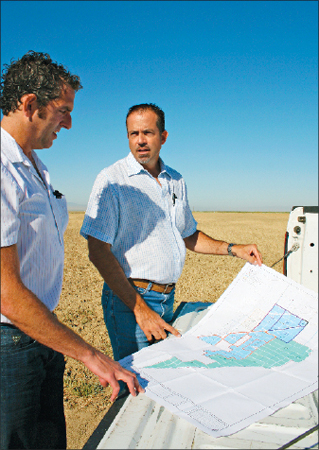By Christine Souza, California Farm Bureau Federation
As energy planners and utilities look for ways to meet a California mandate that one-third of the state’s electricity come from renewable energy by 2020, developers increasingly look at productive farmland as sites for large-scale solar installations.
In one of the state’s most productive agricultural regions, the Central Valley from San Joaquin County to Kern County, about 33,000 acres worth of solar projects have been proposed to the California Energy Commission.

California Farm Bureau Federation Director of Taxation and Land Use John Gamper said most of the utility-scale solar projects would be built on farmland.
Gamper said Farm Bureau does not oppose locating utility-scale photovoltaic solar projects on marginal or physically impaired farmland, but does oppose taking prime farmland out of production specifically for solar development.
“What is important is we don’t allow this 21st century ‘Gold Rush’ to get out of hand and jeopardize our food security, our watersheds and habitat areas,” Gamper said. “We just have to be thoughtful. There’s plenty of public land, desert land and non-productive farmland, so we don’t have to put large-scale solar on prime farmland just because it is close to a substation.”
Much of the farmland targeted by developers has been conserved through the California Land Conservation Act, or the Williamson Act. Some public officials have opted to take land out of the Williamson Act to install solar, including Fresno County, where the board of supervisors recently voted to remove 90 acres of prime farmland from its Williamson Act contract.
“There are some big promises being made out there. We have about 33 solar projects proposed for our Westside, and 17 are enrolled in Williamson Act contracts, so this is a big deal,” said Fresno County Farm Bureau Executive Director Ryan Jacobsen.
Chris Scheuring, California Farm Bureau managing counsel for natural resources and the environment, said the organization strongly supports a landowner’s property right, but believes the integrity of the Williamson Act must be protected.
“As an agricultural organization, we believe farmland is a crucial environmental resource and we have strong feelings about the future of agriculture,” Scheuring said, re-emphasizing the belief that utility-scale solar projects should be directed to marginal lands.
One project that would be located on physically impaired land involves a large-scale solar development in Kings County known as the Westlands Solar Park. The project is proposed on 30,000 acres of land owned by three private landowners and Westlands Water District. The land includes properties affected by lack of drainage facilities to remove water runoff containing high levels of selenium.
Daniel Kim, a principal partner in Westside Holdings, a pre-development organization planning the Westlands Solar Park project, said the project is unique among others in the Central Valley because the land has been given a state designation as a competitive renewable energy zone and the project is unanimously supported by agricultural and environmental organizations.
“The Westlands Solar Park lies on farmland that is no longer as productive as before due to a combination of diminishing water supplies in the Central Valley and the lack of drainage infrastructure for removing selenium from the soils,” Kim said. “The land within the Westlands Solar Park also has the advantage of being under existing transmission, which makes it an ideal location for a large solar park.”
Mark Shannon, a third-generation diversified grower who farms near Lemoore, is one of the landowners who has agreed to partner in the Westlands Solar Park project, although he acknowledges that his family would rather be farming the ground.
“If we had drainage and if we had a reliable water supply, we can farm this property. But the likelihood of the federal government stepping up and providing a drain, that’s not going to happen,” Shannon said. “Looking at this realistically over the next 10, 15, 20 years, it is going to be a battle for water every year. So if you can’t farm all of your property, you have to look for an exit strategy. Obviously, solar is a realistic exit strategy.”
Farmer Ted Sheely, who has also elected to take part, said this year provides a great example of why the solar project works for his family.
“I’ve got 1,000 acres I didn’t farm again this year because of an unreliable water supply. All of the indications were there, but by the time the water supply was announced, there was no crop I could plant,” said Sheely, who farms cotton, wheat, lettuce and garbanzo beans. “This is a good place for solar, as opposed to some of the other places that are being talked about.”
Editor’s Note: This story comes to us courtesy of the California Farm Bureau Federation, which allowed for reprinting of it. Author credit goes to Christine Souza, an assistant editor of Ag Alert. It is the second of a two part series looking at the effects on agriculture from solar power.